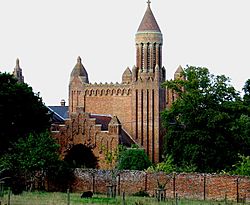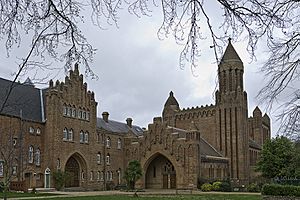Quarr Abbey facts for kids

1912-rebuilt Quarr Abbey
|
|
| Monastery information | |
|---|---|
| Order | Benedictines |
| Established | 1132 |
| Disestablished | 1536 |
| Reestablished | 1912 |
| Diocese | Portsmouth |
| People | |
| Founder(s) | Baldwin de Redvers, 1st Earl of Devon |
| Architecture | |
| Status | Active |
| Heritage designation | Grade I |
| Style | French, Byzantine, Moorish |
| Site | |
| Location | Ryde, Isle of Wight, England |
| Public access | Yes |
Quarr Abbey is a special monastery located on the Isle of Wight in southern England. It's pronounced "Kwor," like the word "for." This peaceful place belongs to the Catholic Order of St Benedict, a group of monks.
The buildings and church you see today were finished in 1912. They are very important because of their unique design. Experts like Sir Nikolaus Pevsner called the Abbey "among the most daring and successful church buildings of the early 20th century in England."
The Abbey was built using Belgian brick. Its style mixes French, Byzantine, and Moorish designs. You can still see small parts of the much older, original abbey nearby.
A small group of monks lives at Quarr Abbey. They follow a quiet, regular life and also manage a farm. Sometimes, they offer special programs for young men to learn about their way of life.
Contents
History of Quarr Abbey
The First Abbey: A Cistercian Home
The first Quarr Abbey, called St. Mary's Abbey, was built in 1132. It was founded by Baldwin de Redvers, 1st Earl of Devon, who was an important leader on the Isle of Wight. This abbey was part of the Cistercian Order, another group of monks.
Baldwin de Redvers was buried at the Abbey in 1155. A royal princess, Cecily of York, who was King Edward IV of England's daughter, was also buried there. Many other important people found their final resting place at this medieval monastery.
The name "Quarr" comes from the word 'quarry'. This is because there used to be a stone quarry nearby. Stone from this quarry was used for many buildings, including parts of the famous Tower of London.
The abbey became a very rich and important place. Because of its value, the abbot (the head monk) was often in charge of the whole island. In 1340, the monks even got special permission to build walls and gates to protect the abbey from pirates. You can still see parts of these old defenses today.
When the Abbey Changed Hands
In 1536, a big change happened in England called the Dissolution of the Monasteries. This is when King Henry VIII closed down many monasteries. Quarr Abbey's land was bought by a merchant named George Mills.
He tore down most of the old abbey. Its stones were then used to build forts in nearby towns like Cowes and Yarmouth. One of the abbey's bells is still used today in a nearby church that the monks originally built for local people. Some of the salvaged stone was also used to build a house called Quarr Abbey House.
The Modern Abbey's Story
Monks in Exile: Finding a New Home
In the late 1800s, a law in France made it difficult for religious groups to exist. Because of this, the Benedictine monks from Solesmes Abbey in France had to look for a new home. Their leader, Abbot Paul Delatte, sent a monk to England to find a safe place.
In 1901, a new law in France made it even harder for them. The monks remembered that their founder, Prosper Guéranger, had thought England could be a good refuge. They had already taken over Farnborough Abbey in England, which held the tomb of Napoléon III.
A Temporary Home: Appuldurcombe House
By the end of July 1901, the monks found a large house on the Isle of Wight called Appuldurcombe House. It was a good fit for them. The house had been built in the 1700s and was once home to a famous art collection.
The monks quickly moved from Solesmes to the Isle of Wight. By September 1901, almost all the monks from Solesmes were living at Appuldurcombe House.
Building the New Quarr Abbey
In 1907, some monks moved from Appuldurcombe to the site of Quarr Abbey House. They started preparing the land, building fences, and planting an orchard.
One of the monks, Dom Paul Bellot, was an architect. He designed the amazing new abbey, adding to and extending Quarr Abbey House. About 300 local workers, who usually built houses, helped construct this unique building.
The dining hall and three sides of the cloister (a covered walkway) were built in just one year, starting in 1907. The rest of the monks moved from Appuldurcombe. In April 1911, work began on the Abbey church. It was finished quickly and officially opened on October 12, 1912. The church has tall, pointed towers made of glowing Flemish brick, giving it a touch of Byzantine style.
After World War I, in 1922, most of the Solesmes monks returned to France. A smaller group of monks stayed at Quarr. In 1937, Quarr became its own independent abbey, and English monks joined the community.
Protecting the Abbey for the Future
Over time, the abbey buildings started to show their age. The World Monuments Fund listed Quarr Abbey as one of the most endangered historic sites. In 2012, the Heritage Lottery Fund gave Quarr a large grant of £1.9 million to help.
This money is being used to fix and preserve the old abbey ruins and the current abbey church. They are also building a visitor center and offering training for local college students in construction. Repairs are also being made to the Bellot Abbey to stop rain from getting in.
In July 2013, the Abbey hosted a special five-day course. People learned about early polyphony (music with multiple independent melodies) and Gregorian chant (a type of sacred song).
Leaders of the Abbey
- Dom Marie-Gabriel Tissot, OSB, Abbot 1937 - 1964
- Dom Aelred Sillem, OSB, Abbot 1964 - 1992
- Dom Leo Avery, OSB, Abbot 1992 - 1996
- Dom Cuthbert Johnson, OSB, Abbot Aug 1996 - March 2008
- Dom Finbar Kealy, OSB, Prior Administrator 2008 - 2013
- Dom Xavier Perrin, OSB, was appointed as Prior Administrator in May 2013. He was elected Abbot by the community on May 11, 2016.
Quarr Abbey in Books
Quarr Abbey has been mentioned in some interesting books:
- Tony Hendra wrote about his experiences at Quarr Abbey in his 2004 book, Father Joe: The Man Who Saved My Soul.
- In his 1929 book, Good-Bye to All That, Robert Graves described visiting Quarr Abbey while recovering on the Isle of Wight during World War I. He said the fresh food at the Abbey helped him change his mind about Catholicism.
Burials in the Old Abbey
- Baldwin de Redvers, 1st Earl of Devon and his wife Adelize Ballon (died around 1146)
- Cecily of York and her husband Thomas Kymbe
Images for kids





